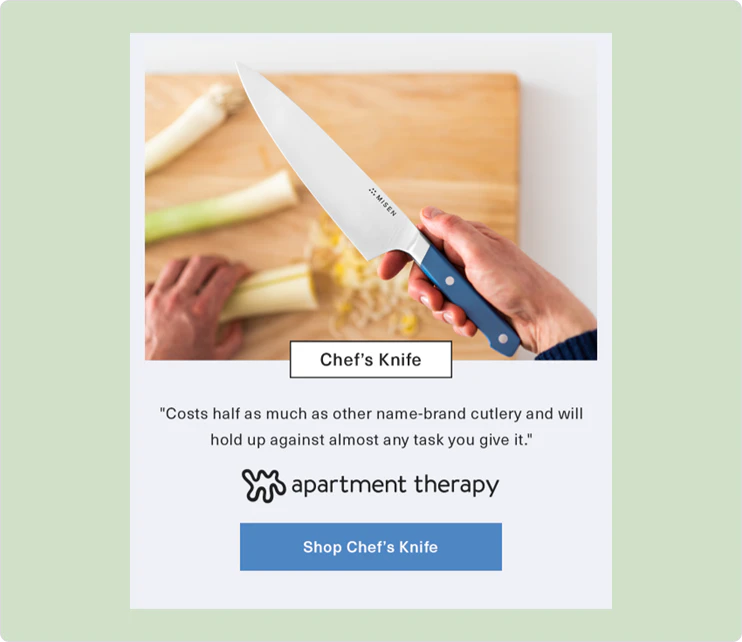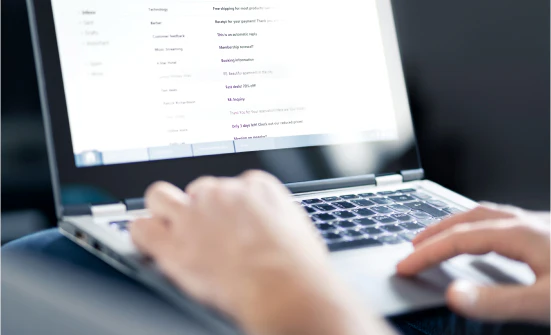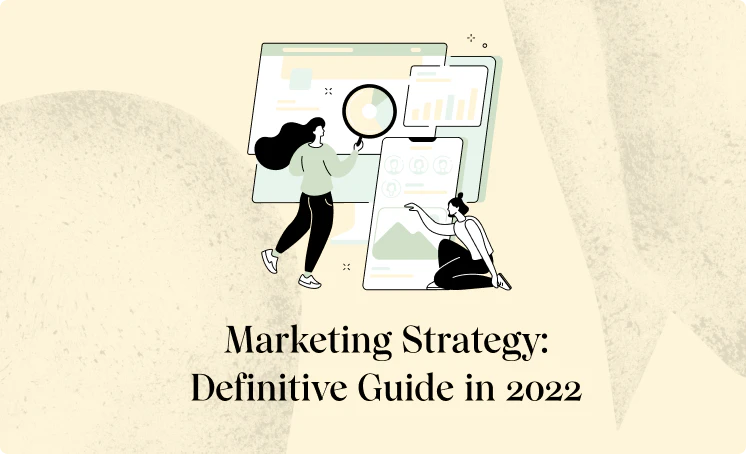Introduction
Email marketing benchmarks are useful because they give you an initial target. The ultimate goal, though, should be to exceed the average benchmarks for your industry.
In this article, we’re going to help you understand how to improve four primary email marketing metrics — opens, click-through, bounce, and unsubscribe.
Let’s get right into it.
The average email open rate is 21.33%.
According to a study from MailChimp, the average open rate for emails will vary widely across industries but it is 21.33% across all industries. For example, the supplement industry sees average open rates as low as 15%, whereas the arts (26%), hobbies (27%), and religion (27%) industries are much higher.
Remember, an average means that around half of the businesses are getting better open rates. So you should aim to be in the top range, and if you aren’t, we have some tips to help.

How To Improve Your Open Rate
1. From name
Your subscriber is shown three pieces of information before opening your email – from name, subject line, and preview text – and each provides valuable insight.
The from name tells your subscriber who is reaching out to them. It can either be your brand, an influential person within your brand, or a combination.
As a general rule, any emails sent to build a connection should come from a person within the company. The from name can be just the person’s name if it’s built around a personal brand, but more often, it should come from “name @ brand.”
2. Subject lines
Subject lines have been thoroughly researched and debated. The consensus on the best subject line is: it depends.
When crafting your subject lines, you need to consider your goal and your audience. Are you emailing new customers or VIPs? With the VIPs, straight to the point might work better because they are already fans, whereas new customers might need something focused on incentives or benefits.
If you are in your target audience, go through your inbox and pay attention to what gets you interested in opening. Otherwise, try to find someone who is in your target audience and ask them to browse their inbox and share with you the subject lines that appealed to them.
3. Preview text
Email services preview text varies from as few as 40 or as many as 140 characters. Either way, that’s not a lot of room to sell your subscriber on opening your email.
Knowing that you have limited space, your best choice is to frontload your most valuable information. That way, if your preview text is cut off, then your reader still gets the general message.
4. A/B test everything
You know you should A/B test all elements of your email, but the from line and subject line should be the very first thing that you test.
Getting your emails opened by a larger number of subscribers will boost your audience for testing each element further along.
5. Segmentation
Segmentation is the most powerful tool for email marketing. According to HubSpot, segmented campaigns may generate as much as a 760% increase in revenue.
The list of ways you can segment your list is plentiful, especially when you start combining attributes. Demographic and behavioral data are good places to start, though.
There is no one right way to segment for everything. However, as you learn about your subscribers, you can refine your strategy.
6. Ask your subscribers to whitelist your emails
When your subscribers add your email to their contact list or move your emails from the Promotion tab to the Primary tab in Gmail, they are “whitelisting” your emails or telling their email service that your emails aren’t spam. You can ask your subscribers to whitelist your emails in your welcome email.
7. Share what’s inside
If you are sending an email that comes with an extra incentive to open, go ahead and include information in the subject line.
For example, you might add [Video] or [Training] to the end of your subject line to create interest with your subscriber.
8. Deliverability
If you don’t stay out of the spam filter, your emails won’t even get seen, never mind opened.
Deliverability improves the more you can keep your subscribers engaged and your sender reputation clean. Takeaway: send emails your audience wants to receive and don’t spam.
The average click-through rate is 2.62%.
Similarly, average click-through rates will fluctuate by industry. But you may be wondering why there is a dramatic drop-off from the average open rate.
It takes your subscribers very little time to open an email and scan over it, but taking action requires a bigger commitment. To get an email opened, you simply need to make your reader curious. However, if you want them to click-through, you need to convince them that they will get value from taking action.

How To Improve Your Click-Through Rate
1. Find out what your audience wants
You can find out exactly what your audience wants in three ways:
- Reviews and data – Past customer reviews and data will give you a clear picture of what is and isn’t working for your audience. For instance, if you find several reviews that your product was difficult to use because they didn’t have enough instruction, you can start sending emails that include written or video instructions when your customer orders.
- Ask them – The fastest way to find out what your audience wants is to come right out and ask them. Once you find out what appeals to each segment of your audience, you can tag them in your system to receive offers personalized to them in the future.
- Test different CTAs – If you don’t get a high response rate from your audience, then it’s time to start testing different types of CTAs. This method will take the most time, but the results will be definitive.
2. Test hyperlinked text vs. buttons
You may not think that hyperlinked text vs. buttons matter, but you’d be surprised. Some people won’t click the hyperlinked text but will click a button and vice versa. It depends on what they are used to seeing from other brands they commonly interact with.
Perform a bit of quick research on other successful brands related to your market. Do their emails include primarily hyperlinked text or button CTAs?
3. Link your images
You should be providing as many opportunities as possible for your reader to click through. Don’t forget to link any images you include in your emails. Linking images is especially important if you are an ecommerce brand where customers are used to clicking images to take them to the product page.
4. Write better CTAs
So, how do you write a better CTA? You make them clear and benefit-driven. Instead of “shop now,” you could try something like, “shop the sale now to save up to 40%.”
Don’t be afraid to test longer CTAs, even on buttons. Clearly stated benefits are more valuable than short copy in most cases.
5. Don’t save CTAs for the bottom
You need a CTA at the end of your emails, but you may also want them at the beginning and middle, depending on the length of your article and how warm your audience is.
If you are using long emails, you want CTAs sprinkled throughout so that your subscriber can click through as soon as they are ready. Top of email CTAs should also be utilized for subscribers that are known to have high buying intent, like VIP customers.
6. Test your CTAs
At the end of the day, the best way to improve your click-through rate ongoing is to test your CTAs regularly.
Test various types of CTAs across each segment. Start with different offers, then test the style of copy followed by the CTA design and placement.
7. Provide value in your copy that makes them trust you
Convincing your subscribers to click-through takes more than a highly relevant call-to-action, though.
The rest of your copy needs to support your CTA and provide insights that builds trust with your audience. The more targeted you can make your supporting email copy, the better your CTA’s will perform.
8. Tell them what happens next
Often, your subscribers won’t take action if they aren’t sure what will happen next.
People have a fear of the unknown, especially when it comes to spending money. So for your readers to feel confident enough to click, you should make it clear what will happen after clicking.
With CTAs like “shop,” the customer has a pretty good idea that it will lead to a category or product page, but with other CTAs like “discover,” there is room for interpretation. In those instances, you need to make sure you are describing the next step.
For instance, if the next step is a training on your product, you’ll want to explain the cost associated (ideally, free to get more action) and a few of the learnings they will walk away with and why they matter — how what they learn will save them time, money, or make their life easier.
The average bounce rate is 4.31%.
Your bounce rate is the percentage of emails you sent that couldn't be delivered to the intended recipient for whatever reason divided by overall emails sent, times 100. Sometimes an email will bounce because a subscriber changed their email address. Other times, it is because an email provider kicked out your email because it wasn't trustworthy.
Per data pulled from Benchmark users, bounce rates can be as low as 2% but up to 7%.
Having a high bounce rate hurts your email marketing efforts long-term, so it’s essential to keep your rate low.

How To Decrease Your Bounce Rate
1. Never add subscribers from a paid-for list
This may seem obvious, but so many people do this when starting. Not only is it illegal to email people who haven’t subscribed to your list, but these lists will severely damage your sender reputation.
Most lists on the market aren’t cleaned and cross-checked, so you will likely have a lot of emails that bounce.
2. Set up double opt-ins
Yes, double opt-ins can be a pain, but they are actually required with GDPR. While GDPR isn’t international, other countries are enacting similar legislation.
It’s better to be prepared and start using it now. Plus, it ensures the email provided is a working email and will lower your bounce rate.
3. Don’t use free email services to send mass emails
Just because you can send emails to a list with a free service like Gmail doesn’t mean that you should.
Because these services aren’t meant to send mass emails, if you don’t know how to properly authenticate your domain, your emails are more likely to fail the DMARC check and potentially bounce.
Use a reputable service that focuses on email marketing. Many have free base plans for brands with small email lists to help you get started.
4. Send emails regularly to make sure your list doesn’t go stale
Even lists curated genuinely can go stale. People change their emails, and old email inboxes get full. There is a list of issues with ignoring your list.
You need to send regular emails to prevent a high bounce rate caused by inactivity on your part.
5. Scrub your email lists regularly
Don’t let people linger on your list if they aren’t engaging. It costs you resources that are better spent focusing on active subscribers.
If a person regains interest, they can always sign up to your list again.
6. Authenticate your domain
Domain authentication tells the email service that you are who you say you are and that your email is not some kind of phishing scam attempt.
Authenticating your domain requires setting up DKIM and SPF records. Most providers make it easy to verify your domain. If you can’t find a how-to for your service, check with customer support to point you in the right direction.
The average unsubscribe rate is 0.20%.
Based on that same study of Benchmark users, the average unsubscribe rate is relatively low.
While you don’t want a high unsubscribe rate, you have to expect a certain percentage of your subscribers to exit your list. Depending on your industry, customer churn is normal, and it saves you from paying for a subscriber who is no longer interested.
If your unsubscribe rate is high and you’re concerned you’re losing subscribers that are actually valuable to your business, there are a few steps you need to take.

How To Decrease Your Unsubscribe Rate
1. Set expectations of how often to expect to hear from you
When you set expectations for your users, they will know what they are signing up for before committing and be less likely to unsubscribe when you start showing up in their inbox frequently.
Let your readers know, for instance, that you will send a weekly update if that’s your plan.
2. Allow users to choose preferences
Even better, give your subscribers the ability to choose how often they hear from you and what lists they are on. Allow them to opt-out of specific campaigns like newsletters or any extended sales sequences.
Remind your readers that they can update their preferences regularly, so they don’t forget and jump to the unsubscribe.
3. Encourage users to self-segment
Another way you can keep your email relevant to your subscribers is by asking them to self-segment periodically.
Self-segmenting is simple. The subscriber will click a link that best represents them, and they will be tagged accordingly in your email system. This is a great asset for brands that serve broad audiences.
4. Value statement above unsubscribe
A tactic worth trying that isn’t as well-known yet is to include a brand value statement at the bottom of your email directly above the required unsubscribe.
Use the value statement to remind readers why they are one of your people. It helps to foster a sense of community, and people don’t like to feel like they are abandoning their community.
5. Watch what causes people to unsubscribe
Does a particular type of email cause a spike in unsubscribes? Do more people unsubscribe the more you email them?
Start looking for patterns that may be able to provide insight into what drives your subscribers away.
6. Ask for feedback upon unsubscribing
Some subscribers are just going to unsubscribe no matter what you do. But that doesn’t mean they can’t provide you valuable data.
Be sure that you're collecting feedback from readers upon unsubscribing to learn what is causing them to leave. It may simply be that they no longer need what you offer.
5 Tips for Exceeding Email Marketing Benchmarks

So far, we’ve covered tips targeted at improving open, click-through, bounce, and unsubscribe rates. Now let’s look at some tips for improving your overall email marketing.
1. The importance of subject lines cannot be overstated. You should spend as much time as possible learning about what subject lines perform the best with each segment of your audience. Take the time to create templates based on your top-performing subject lines to tweak and use when you’re in a hurry.
Some popular templates to test with your subject lines include:
- Short statement? – Ex. Does this drive you crazy too?
- “Unattributed quote” – Ex. “This moisturizer is the best!”
- Short and vague curiosity-building – Ex. You in?
- Bracketed teaser – Ex. This is the future of retail [video]
Subject lines that are either very short or quite long will stand out in your reader’s inbox. Another way to help your subject line catch your subscriber’s attention is through punctuation or emojis. The critical piece is that your subscribers don’t just glance right over your email.
2. Remember, your subject lines don’t work if they aren’t seen. You have to make staying in subscribers’ inboxes a priority. You have to understand how to avoid triggering the spam filter. Certain words are more likely to trigger it, but other actions like including attachments might trigger it as well.
Once you start ending up in too many subscribers' spam folders within one email service, they may start marking your emails as spam for other users as well. Therefore, you need your subscribers to let the email service know that your emails are valuable and need to be placed in the inbox.
Many email marketers focus only on conversions, but occasionally you need to prioritize engagement. The more you can get subscribers to reply to or forward your emails, the better luck you will have with avoiding the dreaded spam trigger.
3. Clean your list. We briefly covered this in the bounce rate section, but you don’t just clean it for old emails. You clean your list to keep it healthy and keep your deliverability high. You clean it to avoid allocating resources to chasing subscribers who have shown they are no longer interested.
The best way to clean your list without losing subscribers that would have potentially become customers is to run a re-engagement sequence.
A re-engagement sequence is simply a series of emails targeted to subscribers that have stopped opening your emails. These sequences are typically 3-5 emails sent quarterly.
In the emails, you let the reader know that you noticed that they no longer open your emails and are wondering if they still want to hear from you. Most re-engagement sequences require the subscriber to take action to stay on the list, like clicking a link that will move them back to your active subscribers.
4. Create detailed segments. The more specific you get, the more you can personalize your emails and improve your metrics.
Segments should be created for each persona you serve, then become more specific from there.
For example, if you sell to both men and women, you want to segment them immediately. Then, you can start segmenting by other demographic, psychographic, and behavioral data.
You may want to create a segment for women who live in Australia and have purchased at least once in the past 60 days for a campaign you’re about to send.
Don’t forget that you don’t have to create new email campaigns for each segment. Instead, you should use dynamic content to your advantage to send personalized images and copy to subscribers based on their tags.
5. Create automated flows that nurture prospects through specific periods, for instance, immediately upon signing up to your list or entering a giveaway.
When a subscriber signs up to hear from you, they should not be ignored. While you are top of mind, they should start receiving communications. The best way to make sure no one falls through the crack is automation.
Automation ensures you aren’t missing a chance to connect because something came up. Plus, it allows you to thoroughly test every element in a way one-off emails cannot. The data and time saved are invaluable.
Welcome and re-engagement automations are just the beginning. Flows can be set for any goal you have.
A few of the more popular flows, especially for ecommerce brands, are:
- Browse abandonment
- Cart abandonment
- Post-purchase
- Cross-sell and upsell
- Back in stock
But flows are valuable beyond ecommerce. For example, SaaS often has flows set up for trial customers they want to convert to paid users, and they also use them to upsell plans to current users.
Once you get started, the options are truly endless.
Email Statistics: 2021 Update

As everyone knows, 2020 threw a wrench in everyone’s plans. So you may be wondering if there is anything you need to know for 2021, but as far as email marketing goes, the same questions apply.
What exactly are the open and click-through rates for each industry?
The exact rates for each industry will depend on where you are getting your data from.
Typically, companies like Klaviyo will publish benchmarks for the previous year, so updates for 2021 are based on 2020 data. As we all know, 2020 was a crazy year with explosive growth in some industries and near decimation of others. You’ll want to keep this in mind.
With that being said, Campaign Monitor published a compilation of benchmarks across several industries that you can refer to help you measure your efforts against.
Do larger companies have stronger email marketing benchmarks?
Big businesses may have more subscribers, but they perform comparably with email marketing.
Both small and large companies need to follow the same rules to improve their email benchmarks. The difference is that big businesses have to effectively manage more subscribers, which means more data that can make them slow to pivot if something isn’t working.
What email clients are subscribers most likely using?
According to Litmus, Gmail is the most popular email service on both desktop and mobile. Apple follows closely, especially on mobile.
So, at the very least, you should test send your emails to a Gmail and Apple account and look at it on both desktop and mobile.
It would also be wise to send it to a Yahoo and Outlook account, as they are the other ranking email clients.
What should I consider a “good” open and click-through rate?
Giving a straight answer to this question is complex. It’s going to depend on your industry, but other factors play a big part as well.
For instance, a behavior-triggered email will get more opens and clicks than something like a newsletter. Compare your metrics to your industry benchmarks and then consider the type of email sent to determine if your email is performing well.
Ultimately, you should always be trying to improve your current metrics, even if you are already above your industry average.
Need Help Improving Your Email Marketing?
Now that you know the average benchmarks for your industry and all the steps required to boost your own results, you may be realizing you don’t have the time needed to implement your complete email marketing strategy.
If you are looking to outsource your email marketing success, we’d love the opportunity to show you what we can do.
When you partner with us, you have your email strategy executed by specialists that know precisely what metrics matter and how to improve them. You never have to worry about constantly checking your data or if you’re segmenting your lists correctly because we’ll take care of it for you.
Final Thoughts
Email is a channel that gives you the data – not an algorithm – to improve your results.
You should look at average email marketing benchmarks to identify opportunities within your industry.
Do some competitor research and figure out what they are missing in their email marketing that you can focus on improving using the tips within this article.



.webp)










.webp)









.webp)










































.webp)






